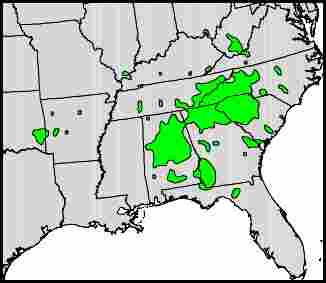Carolina Silverbell
(Halesia tetraptera)
The Carolina Silverbell is a deciduous woodland tree native to the central and southern United States. It gets its name from the beautiful bell-shaped blossoms that hang from the branches in mid-spring. These blossoms, about 3/4 inch long, are usually pure white, but can also be pink. Whatever the color, they have a delicate beauty that no one will forget.
The tree typically grows about 30 feet tall, but a large form known as Mountain Silverbell can reach 100 feet. This form, found mainly in the southern Appalachians, is sometimes classified as a separate species (Halesia monticola). It has larger leaves and flowers than the smaller form.
The tree can grow in fairly heavy shade, and is usually found in moist soil, often near streams. The leaves are oval-shaped, and can turn to a clear yellow before dropping in autumn. The fruits are winged drupes about one inch long which are sometimes eaten by squirrels. Because these drupes have four wings, the plant is sometimes called Four-winged Silverbell. Its scientific name, formerly Halesia carolina, has been changed to Halesia tetraptera.
This species is found over a fairly large geographic area, as far north as West Virginia and southern Illinois, as far west as Oklahoma, and south to northern Florida. But it is thinly distributed over much of its range, and is becoming increasingly rare in many regions, particularly in populated areas. Fortunately, a number of nurseries are now propagating it and making it available to the public. As more people plant it in their yards, it should eventually get the appreciation it deserves.
Other Information
Scientific Names: Halesia tetraptera, Halesia carolina, Halesia monticola
Common Names: Carolina Silverbell, Four-winged Silverbell, Silverbell
Plant Type: Small to large deciduous tree
Height: 20-40 feet, but mountain form can be much larger
Cultivation Zones: 5 - 8
Native Habitat: In mixed forests, often along streams.
Native Range: Scattered areas in central and southeastern United States, extending west to Oklahoma. See distribution map below.
Distribution Map

Range Map Source: U.S. Forest Service. (See General Note C)
Conservation Status: NatureServe lists Halesia tetraptera as Critically Imperiled in Illinois, and Imperiled in Alabama and Oklahoma. Officially the species is classed as Endangered by Illinois and Presumed Extirpated by Ohio.
Cultivation: Carolina Silverbell may be sensitive to drought and fertilizer burn. Give it a moist loamy soil with good drainage, and go light on fertilizer. A mulch can help preserve moisture during droughts. Exposure to direct sunlight will increase the bloom, but too much sun could cause stress in hot dry climates. The plant may produce multiple trunks or try to grow as a shrub, but can usually be trained into tree form.
Seeds need both warm and cold stratification, and can be difficult to work with. Go to Cultivation and Seeds for more information.
Related Species: A similar species is the Two-winged Silverbell (Halesia diptera), also known as the Snowdrop Tree. This is a southern species, and It can make an excellent alternative in warm climates, but might not survive in the north. Some nurseries sell a special form called magniflora, which has larger and more profuse blossoms. Two-winged Silverbell is slightly smaller than Carolina Silverbell, usually less than 25 feet tall.
Another similar species, Little Silverbell (Halesia parviflora), grows along the Gulf Coast, and could be planted in that region. Its blossoms are only half as big as those of the other two species.
There is also a more distantly-related species called Bigleaf Snowbell (Styrax grandifolius). An understory plant with white bell-like blossoms, it can grow as either a shrub or a tree and seldom exceeds 20 feet in height. A smaller similar species called American Snowbell (Styrax americana) can reach to about 10 feet. Either of these could make a good alternative to the Silverbells where space is limited.
Plant Sources: Carolina Silverbell is usually easy to obtain. Shooting Star Nursery, Woodlanders, Elk Mountain Nursery, Wayside Gardens, Oikos Tree Crops, Musser Forests, Overhill Gardens, Lazy S's Farm, and GroWild often have it available. Some nurseries also sell a special variety called "Uconn Wedding Bells" which has larger and showier blossoms. Pink-flowered forms ("Arnold Pink" and 'rosea") are also sometimes sold. For links to the mentioned suppliers, go to Sources of Plants.
|

